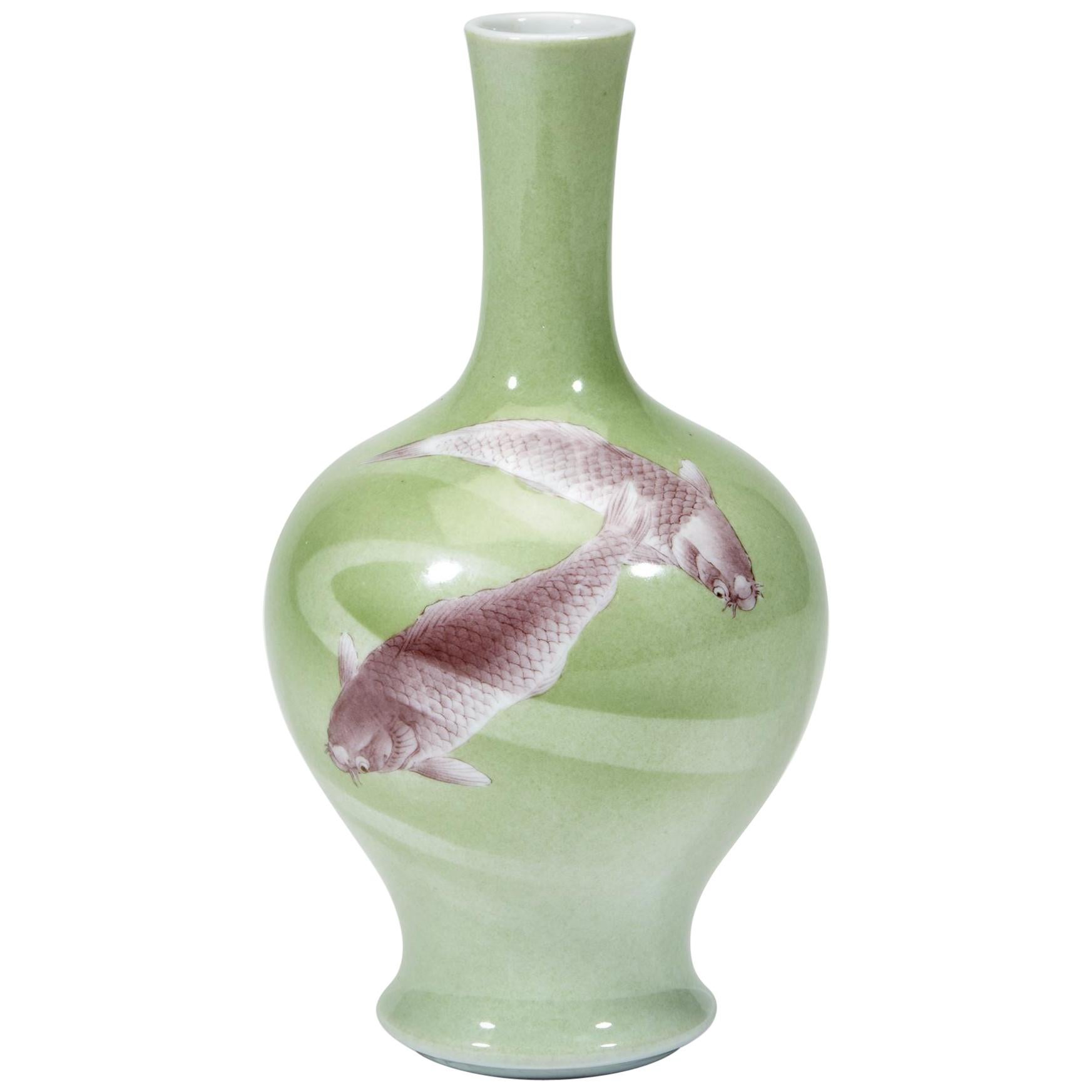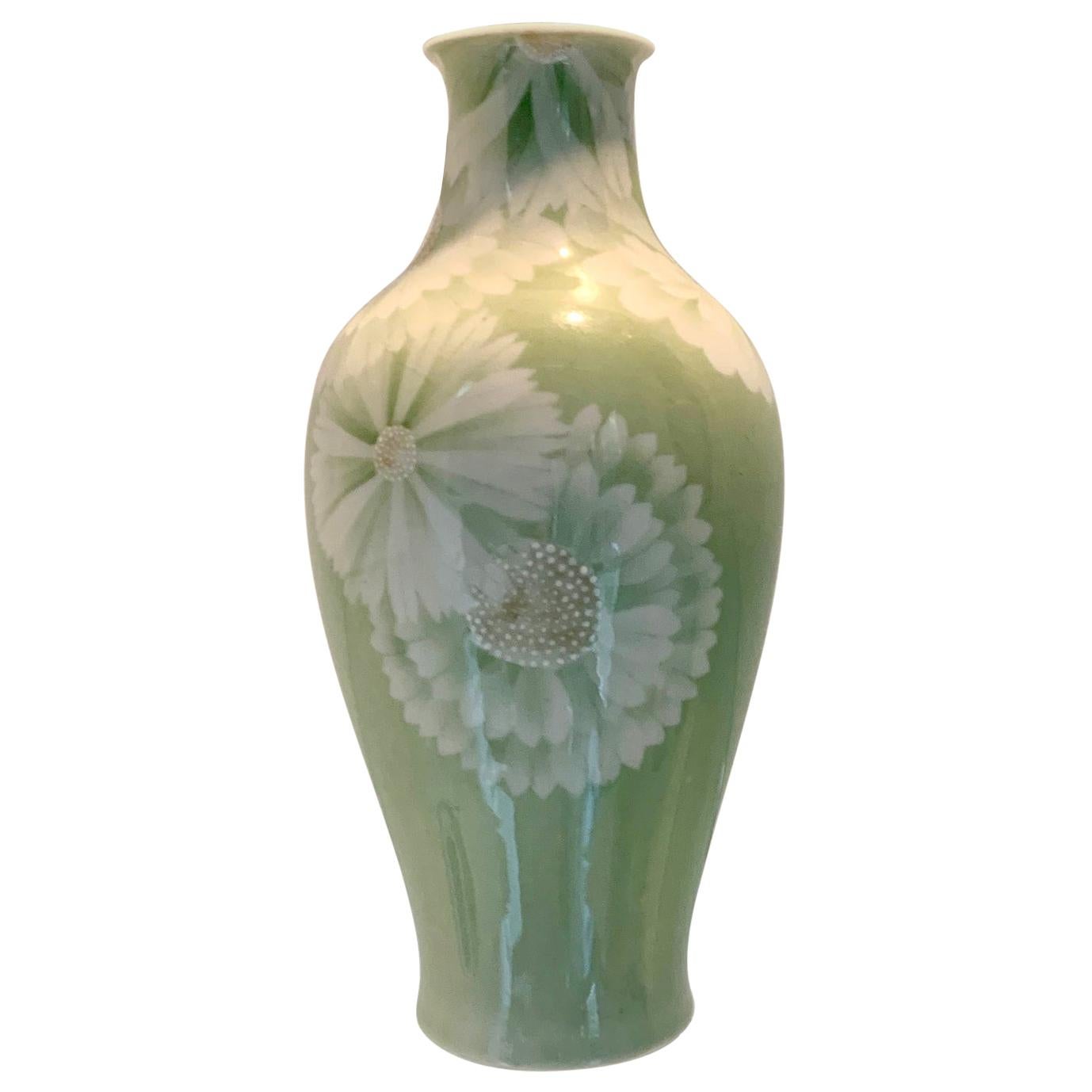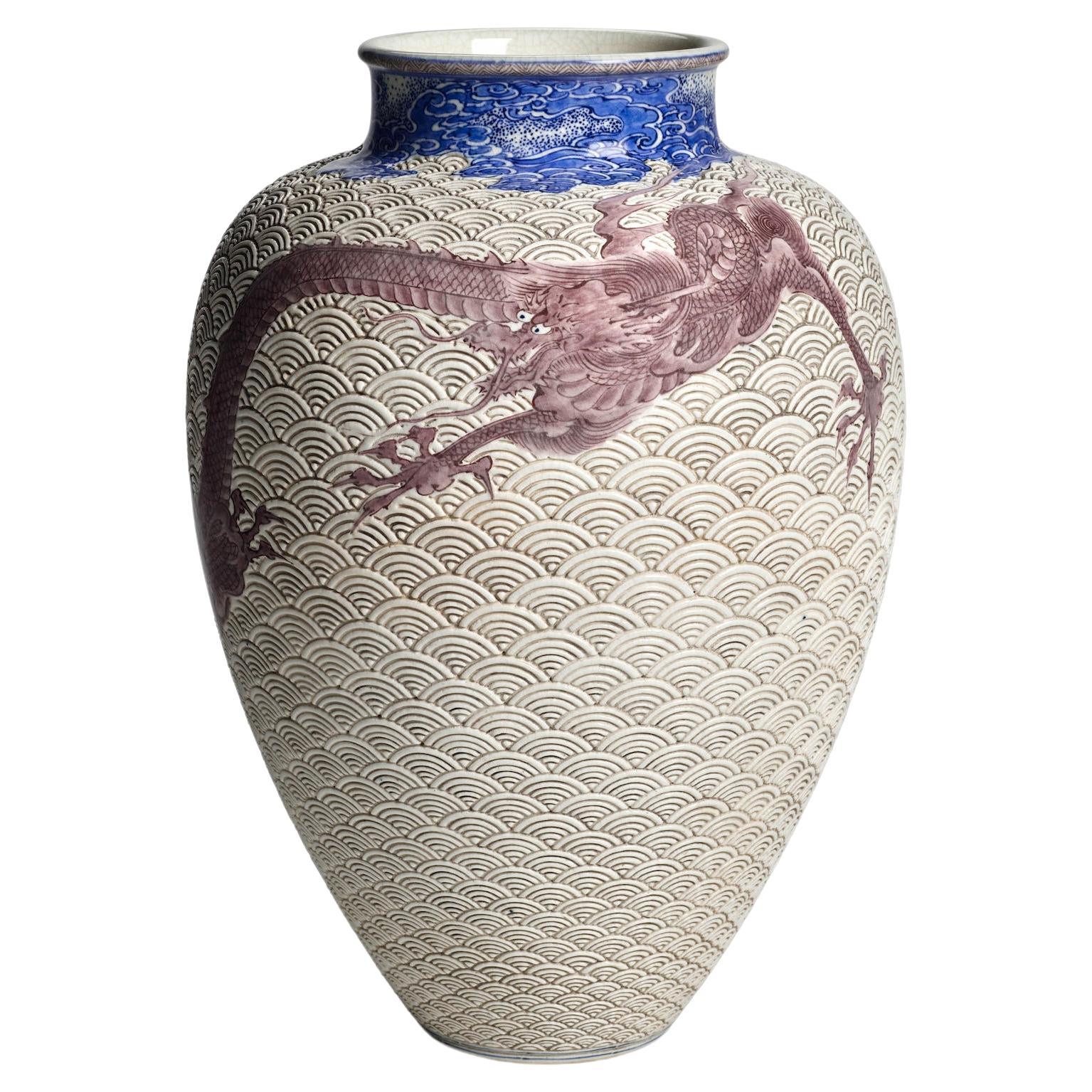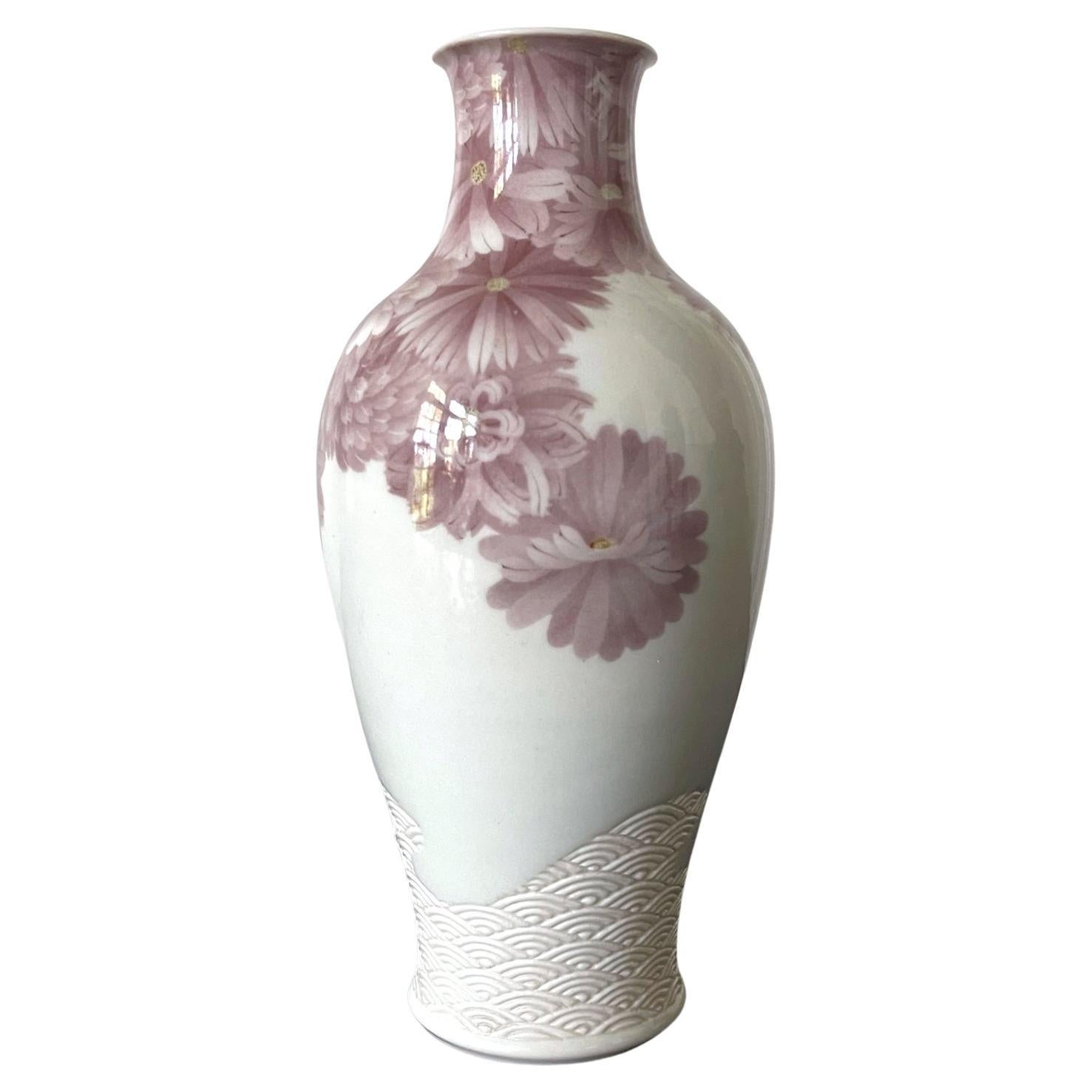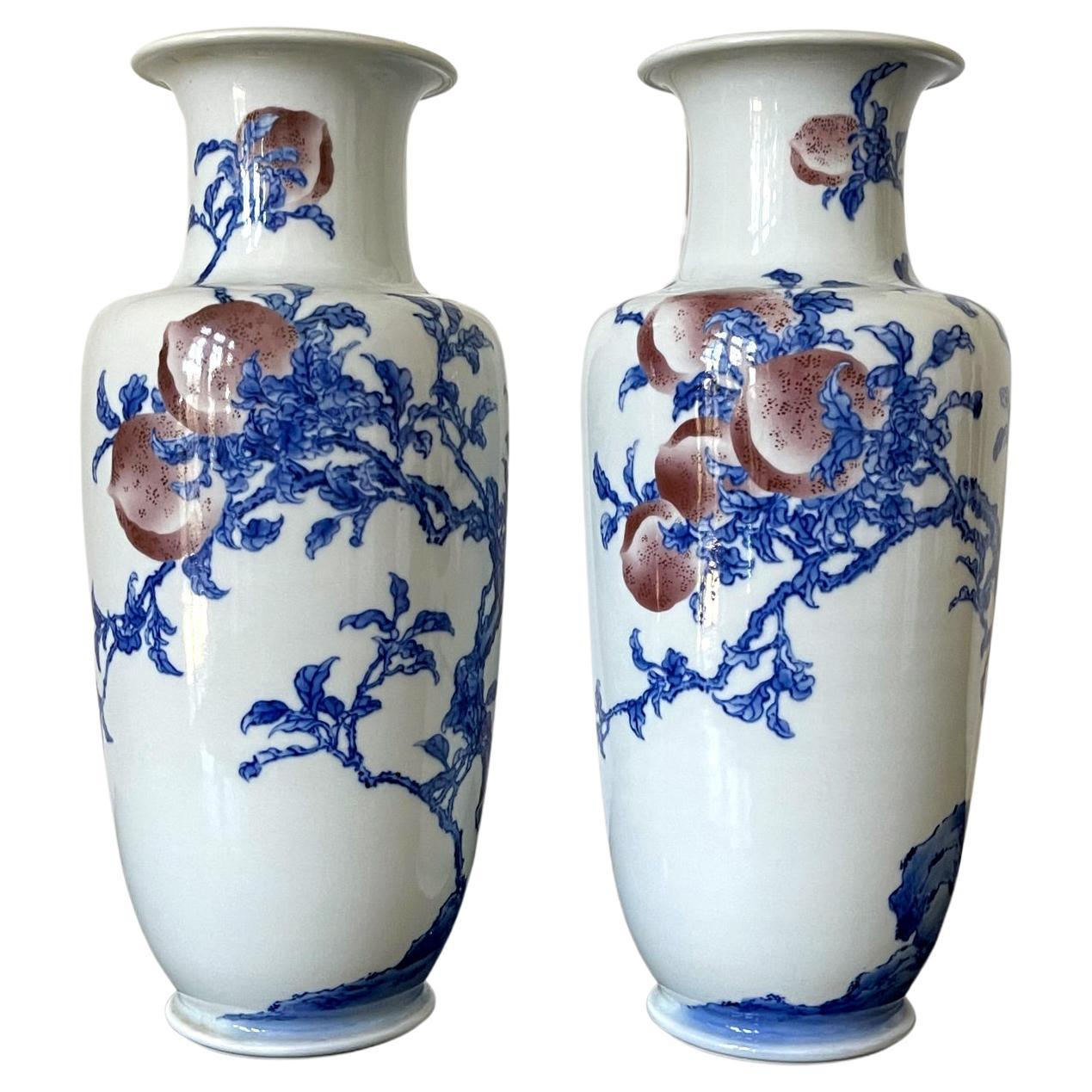Items Similar to One of The Two Japanese Ceramic Vases Makuzu Kozan Meiji Period
Want more images or videos?
Request additional images or videos from the seller
1 of 19
One of The Two Japanese Ceramic Vases Makuzu Kozan Meiji Period
About the Item
Two small nearly identical ceramic vases by Japanese Meiji imperial potter Makuzu Kozan (1842-1916), circa 1890-1900s. The vases were made in the form of jarlet with swelled shoulder in the underglaze period during the late Meiji era. Assembled by chance from different collections in America, the listed price is for one but they will make a lovely pair for a Kozan collection. One vase is slightly taller than the other.
The surface of the vase was decorated on the front in a large copper-glazed carp swimming in a blue and white tinted waves. On the back, a pair of smaller koi were depicted in black enamel, on a overall background of light blue with a pleasant effect of diffusion and gradience. The design is nearly identical on the two vases with very subtle but noticeable variation in details such as the position of the waves, the shape of the fins and the darkness of the black koi etc. They were both marked with the same blue seal on the base. It is likely that the vases were made by the same hand in Kozan's studio. A jarlet with the same design was included and published in his retrospective exhibition (see last two photos). which is likely from the same hand as well.
Despite the small scale, these vases are lovely examples of Kozan's work using underglaze enamel paint with new colors. The paint was done with superb details and style.
Known also as Miyagawa Kozan (1842-1916), he is one of the most established and collected ceramist from Meiji Period. Born as Miyagawa Toranosuke, Kozan established his pottery studio in Yokohama circa 1870s and later became one of the appointed artist to the Japanese Imperial household. Kozan Studio started experimenting with then newly available colors from the west in the 1880s, which resulted in the expansion of the palette and style that bridged the east and west aesthetic tradition. His work was exhibited in many international fairs that the Meiji government participated at the turn of the century and won many grand prizes.
- Creator:Makuzu Kozan (Artist)
- Dimensions:Height: 4 in (10.16 cm)Diameter: 3.5 in (8.89 cm)
- Style:Japonisme (Of the Period)
- Materials and Techniques:
- Place of Origin:
- Period:
- Date of Manufacture:1890s-1900s
- Condition:Wear consistent with age and use. Fine condition, small specks of kiln mark on the base and foot rim as shown.
- Seller Location:Atlanta, GA
- Reference Number:1stDibs: LU945024489852
About the Seller
5.0
Platinum Seller
These expertly vetted sellers are 1stDibs' most experienced sellers and are rated highest by our customers.
Established in 2006
1stDibs seller since 2010
477 sales on 1stDibs
Typical response time: <1 hour
- ShippingRetrieving quote...Ships From: Atlanta, GA
- Return PolicyA return for this item may be initiated within 2 days of delivery.
More From This SellerView All
- Japanese Porcelain Vase Makuzu Kozan Meiji PeriodBy Makuzu KozanLocated in Atlanta, GAA striking blue and white vase from the studio of Japanese Potter Makuzu Kozan, also known as Miyagawa Kozan (1842–1916), one of the most established and collected ceramist from Meiji Period. Born as Miyagawa Toranosuke, Kozan established his pottery studio in Yokohama circa 1870s and later became one of the appointed artists to the Japanese Imperial household. His work was exhibited in many international fairs that the Meiji government participated at the turn of the century and won many grand prizes. Of a relatively large size, this vase is decorated with underglaze cobalt blue using the novel technique developed by Kozan called Fuki-e (the blow painting). As a result, the bamboos appear took on a three-dimensional quality as if appearing in a mist. Known as one of the most creative ceramists, circa 1887, Kozan started experimenting with new chemical colors from the West in the format of his porcelain glaze. New colors allowed him to create underglaze design that appeared bright, smooth and glossy. He even invented his own receipt of cobalt blue to achieve a much brighter yet softer shade, as evident on this vase. To create landscape that is realistic and dimensional, more common in the western paintings, he was inspired by the native Japanese ink painting technique developed around 1900 by Yokoyama Taikan...Category
Antique Early 1900s Japanese Japonisme Ceramics
MaterialsCeramic
- Fine Japanese Ceramic Vase Makuzu Kozan Meiji PeriodBy Makuzu KozanLocated in Atlanta, GAA Japanese long neck porcelain vase circa 1900-1910s by the studio of Miyagawa Kozan (1842–1916), one of the most established and collected Japanese ceramist from the end of Meiji Period. Commonly known as Makuzu Kozan, which also appears as the signature on his work, his originally birth name was Miyagawa Toranosuke. He was the appointed artist to the Japanese Imperial household and his work was exhibited in many international fairs that the Meiji government participated at the turn of the century. This vase features an elegant Classic form with a slender neck and slightly flared mouth above a baluster body. It was finely painted with two swimming carps in a copper red underglaze among green ribbons like waves. The background display a brilliant verdant green overall, Around the fish a poetic hazy effect was emphasized for a visual complexity by Fuki-e (the blow painting), an invention in Kozan's studio. The new technical development of chemical colors from the west was embraced circa 1900s in Kozan studio. This empowered the more creative experiments with not only colors, but also concept of dimension, which led Makuzu Kozan's work to become a bridge between East and West aesthetics. This is particularly evident in this vase with the Masterly details of the brush strokes, the expertly employment of gradient of color, and a very realistic and detailed rendering of the fish and their vivid motions. For two similar examples of Kozan's work with similar carps decoration, see Page 148-149 of the book: Sekai ni Aisa Reta ya Kimono Miyagawa Kozan Makuzu...Category
Early 20th Century Japanese Meiji Ceramics
MaterialsCeramic
- Japanese Porcelain Vase Meiji Period Makuzu KozanBy Makuzu KozanLocated in Atlanta, GAA finely decorated and glazed Japanese porcelain vase by Makuzu Kozan (1842-1916) circa 1900s Meiji Period. The vase is of a classic bottle form with baluster body and short neck. It was decorated with underglaze white magnolia blossom on a pleasant celadon background. The stamens of the flower were artistically rendered in a low relief, giving the design a realistic appeal with the dimension. Miyagawa Kozan...Category
Early 20th Century Japanese Meiji Ceramics
MaterialsPorcelain
- Large Japanese Ceramic Vase by Makuzu Kozan Meiji PeriodBy Makuzu KozanLocated in Atlanta, GAA large Japanese ceramic vase by the celebrated Meiji imperial potter Makuzu Kozan (1842-1916) circa 1880-1890s. Dated to his underglaze phase post 1887 after he successfully mastered the new colors available from the west and used them to the best advantage in his work deeply rooted in Japanese aesthetics. The vase has an impressive size and was potted in the classic baluster form with an elegant proportion. The surface is decorated using a combination of techniques of low relief sculpturing...Category
Antique Late 19th Century Japanese Meiji Ceramics
MaterialsCeramic
- Japanese Ceramic Vase with Delicate Carvings by Makuzu Kozan Meiji PeriodBy Makuzu KozanLocated in Atlanta, GAA delicate and rare Japanese ceramic vase by the important Meiji imperial potter Makuzu Kozan (1842-1916) circa 1887-1910. Dated to his underglaze phase post 1887 after he successful...Category
Antique 1890s Japanese Japonisme Ceramics
MaterialsCeramic
- Japanese Ceramic Centerpiece Bowl Makuzu Kozan Meiji PeriodBy Makuzu KozanLocated in Atlanta, GAA beautiful ceramic vessel in the form of Bo, the so-called monk's alms bowl from the studio of Japanese Potter Makuzu Kozan, also known as Miyagawa Kozan (1842–1916), one of the most established and collected ceramist from Meiji Period. Born as Miyagawa Toranosuke, Kozan established his pottery studio in Yokohama circa 1870s and later became one of the appointed artists to the Japanese Imperial household. His work was exhibited in many international fairs that the Meiji government participated at the turn of the century and won many grand prizes. Of a relatively large size, this piece was made as a decorative center piece for display. It was brilliantly decorated with underglaze paint of a green-on-green bamboo motif, using the novel technique developed by Kozan called Fuki-e (the blow painting). As a result, the bamboos appear took on a three-dimensional quality as if appearing in a mist. Known as one of the most creative ceramists, circa 1887, Kozan started experimenting with new chemical colors from the West in the format of his porcelain glaze. New colors allowed him to create underglaze design that appeared bright, smooth and glossy. To create design that is realistic and dimensional, more common in the western paintings, he was inspired by the native Japanese ink painting technique developed around 1900 by Yokoyama Taikan...Category
Antique Early 1900s Japanese Japonisme Ceramics
MaterialsCeramic
You May Also Like
- Antique Awaji Grey Crackle Glaze Ceramic Vase - Meiji Period - Japan - C.1910By Awaji PotteryLocated in Chatham, ONAntique Awaji ceramic vase - grey crackle glaze - cold painted decoration with red and gilt enamel bird on a branch with flower and leaves - old faint inventory numbers to the base -...Category
Early 20th Century Japanese Japonisme Vases
MaterialsCeramic
- Pair of Meiji Period Japanese Hand Painted Moon VasesLocated in Lambertville, NJA pair of hand painted Japanese Moon vases with foo dog handles. The porcelain vases with hand painted Geisha figures on both sides, the fronts wi...Category
Early 20th Century Japanese Meiji Ceramics
MaterialsPorcelain
- Satsuma Earthenware Vase, by Kinkozan, Japanese, Meiji PeriodBy SatsumaLocated in West Palm Beach, FLA Satsuma Earthenware Vase, by Kinkozan, Japanese, Meiji period (1868-1912) decorated in polychrome enamels and gilt over a clear, crackled glaze, delicately painted with ladies and men, the reverse with a flowering garden with sprays of flowers, the neck with geometric and floral designs, a band of kifu heads in silver and gilt above the foot, on a midnight-blue ground, signed Kinkozan zo...Category
Antique 1860s Vases
MaterialsEarthenware
- Pair of Japanese Meiji Period Imari Vases with Dragon HandlesLocated in New York, NYA Monumental pair of Japanese Meiji Period Imari vases with Dragon handles, Japanese Porcelain Studio Marks on Underside. Each is beautifully ...Category
Antique 1880s Japanese Meiji Ceramics
MaterialsPorcelain
- Makuzu Kozan II Signed and Stamped Japanese Ceramic Flower Pottery Bowl Pot VaseBy Makuzu Kozan IILocated in Studio City, CAA beautiful handmade handled bowl by well-known Japanese ceramic artist Makuzu Kozan II, son of Makuzu Kozan who was appointed artist to the Japanese Imperial household and was one o...Category
Vintage 1930s Japanese Showa Ceramics
MaterialsCeramic
- Pair of Japanese Late Meiji Period Fukagawa Porcelain Vases, circa 1900Located in Takarazuka, JPSuperb pair of Japanese large Meiji period Fukagawa signed porcelain vases (circa 1900). Intricately hand-painted in cobalt blue underglaze with polychrome and gold overglaze on a st...Category
Antique Early 1900s Japanese Meiji Vases
MaterialsGold
Recently Viewed
View AllMore Ways To Browse
Japanese Ceramic Vases
Japan Made Ceramic
Two Centuries Of Black American Art
Wave Japan
Japanese Wave
Antique Japanese Ceramic
Japanese Antique Ceramic
Japanese White Ceramic
Finial Asia
Asian Finials
Asian Ceramic Vases
American Art Studio Ceramics
Japanese Imperial
Japanese Ceramic Collections
Japanese Ceramic Art Pottery
Japanese Waves Art
Japanese Studio Ceramics
Ceramic Japanese Style

